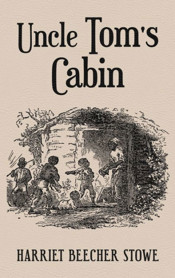Uncle Tom’s Cabin

This is a novel from 1851 designed to reveal the horrors of slavery. And it worked – it caused outrage across the United States and pushed the country toward the Civil War.
The author, Harriet Beecher Stowe, was prompted to write the novel by the passage of the Fugitive Slave Act of 1850, which required all escaped slaves to be returned to their enslavers, even if the slaves had managed to escape to the North. It also made it illegal for any U.S. citizen to assist a slave in escaping.
The plot follows the lives of several slaves:
George and Eliza are a married slave couple with a small child, Harry, owned by different masters. George decides to escape to Canada and send for his wife and child. But when Eliza hears her owner negotiating to sell her son, she escapes as well.
Tom – the “Uncle Tom” of the title – is an older, senior slave who is also sold to a series of new owners.
These slaves drift in and out of the lives of several owners and their children:
Mr. Shelby is the original owner of Eliza, Harry, and Tom. His children are devastated to lose Tom. They loved visiting “Uncle Tom’s Cabin” on their father’s property.
Mr. Haley is the slave trader who Shelby sells Eliza and Harry to. When they escape, he hires a slave hunter to find them.
Augustine St. Clare is the a owner of Tom. His daughter, Eva, loves Tom. St. Clare’s sister comes to live with him from Vermont to assist in raising his daughter when his wife claim’s illness.
Simon LeGree is an evil, violent slaveowner who tortures his slaves and works them to death on his plantation.
The story drifts back and forth between the lives of these people. There are two common themes:
- Slavery was the epitome of pure evil and inhumanity
- Christianity was incompatible with slavery, and all people could find salvation and redemption in Christ
The novel is unabashedly sentimental. Several characters are almost over-the-top in their characterization. Tom is a stoic faithful Christian who eschews all violence and steadfastly believes the Lord will deliver him. But he is surpassed by Eva, who is the picture of angelic childhood and belief.
I learned a few things:
- After the novel was published, “Uncle Tom” became a derogatory phrase for a subservient Black person who aims to please white people, rather than standing up for himself. (I always remember a skinhead calling a Black man “Uncle Tom” in the seconds before the race riot erupted on Geraldo in 1988. I never understood the context before.)
- Being “sold down the river” meant being sent to a plantation – you would literally be sold and floated down the Mississippi on a boat to your new owner. If you were a slave, being a house servant was vastly preferable to working on plantation.
- A constant fear of slave mothers was losing their children. The children were often sold from them. Families were broken up without remorse.
- Slaves were expensive. Several prices were quoted in the book, from $1,000 to $2,000, which is anywhere from $40,000 to $80,000 in today’s money.
- Mixed-race women were very attractive to white men, and therefore very desirable as slaves to be sexually abused. Thus, they commanded a premium.
- Slaves owners often rented their slaves out to factories and for other manual labor.
- Border states had a problem, in that escaped slaves over crossed over the border, thus implicating the residents of the free state in something that was technically illegal. When Eliza escapes, she runs across the frozen Ohio River from Kentucky to Ohio, which was a free state. (This episode was based on something Stowe claims she witnessed.)
The book was an easy read. It’s long, but flows nicely. It was originally a 40-chapter story sterilized in newspapers.
It’s over-the-top in sentimentality. The book has a one-track mind, clearly – Stowe was absolutely laser-focused on condemning slavery and promoting Christianity, so you sort of have to expect that.
It’s a surprisingly good read. The horrors of slavery are readily apparently. Beyond the physical degradation, the threat of breaking up families are ever-present and terrifying. Developing any emotional commitment to another slave was dangerous, because anyone could be sold at any time.
This is one of those books that I remember from high school. I knew it had some significant impact on the history of United States, but it was always floating out there on the periphery on my awareness. I’m glad I finally read it.
Postscript
Added on
Found this in Team of Rivals :
Northern sentiment had been inflamed further by the publication of Harriet Beecher Stowe’s Uncle Tom’s Cabin. Less than a year after its publication in March 1852, more than three hundred thousand copies of the novel had sold in the United States, a sales rate rivaled only by the Bible.
Abolitionist leader Frederick Douglass later likened it to “a flash” that lit “a million camp fires in front of the embattled hosts of slavery,” awakening such powerful compassion for the slave and indignation against slavery that many previously unconcerned Americans were transformed into advocates for the antislavery cause.
Book Info
This book belongs to a collection I am tracking: Easton Press: The 100 Greatest Books Ever Written
- I have read this book. According to my records, I completed it on .
- A hardcover copy of this book is currently in my home library.